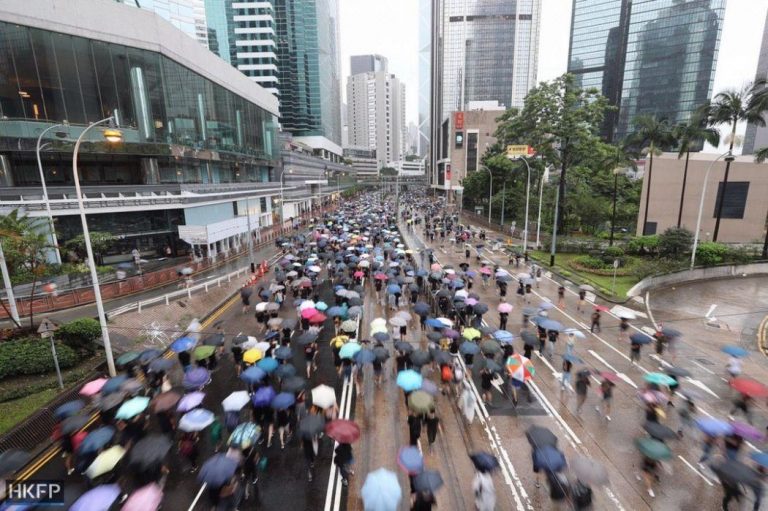For the third time in two months, over 1 million Hongkongers have taken to the streets in defiance of the city’s mainland China-backed authorities. On Aug. 18, crowds gathered in and around Victoria Park on Hong Kong Island, holding umbrellas under the pouring rain to protest police violence and alleged violence by gang members over the last few weeks.
Event organizers from the Civil Human Rights Front (CHRF) estimated the number of protesters at 1.7 million people in Victoria Park alone, but clarified that this number did not account for those crowding the surrounding streets when there was no longer space to enter the park.
The crowds, which had formed despite the city rejecting the CHRF’s protest application, began to disperse around 3 p.m. local time.
This year’s Hong Kong protests began in opposition to a controversial extradition bill that, if passed, would allow the communist Chinese government to have anyone in Hong Kong be apprehended and trialed in mainland Chinese courts. The demonstrations have since evolved into a broader movement to assert Hong Kong’s autonomous status, rule of law, and hold the city authorities accountable to the people, rather than Beijing.
Peaceful resistance to police violence
The Sunday rally was envisioned as a “reset” from the escalating tensions of previous weeks, as well as a response to attempts by Beijing to paint the Hong Kong protests as illegal rioting.
Police have been widely accused of excessive violence against protesters, a large number of whom have been severely injured after being beaten or fired upon with rubber bullets and other non-lethal munitions. One female volunteer medic, whose right eye was shot out on Aug. 11, has become a symbol of public outrage.
Other violent incidents have involved attacks on protesters by men apparently from pro-Beijing triad gangs. On July 21, around 400 white-shirted men showed up in Yuen Long district chasing and beating anyone they suspected of being a demonstrator.
Hong Kong residents have also reported the presence of police provocateurs trying to infiltrate the protests, apparent complicity between police and the triads, and security personnel from mainland China posing as Hong Kong police.

A woman volunteering as a medic had her right eye shot out by a beanbag round, and she became a symbol of resistance against police brutality in the Hong Kong demonstrations. (Image: Screenshot via Twitter)
Media controlled or influenced by the Chinese Communist Party (CCP) has used the chaos to condemn the entire protest movement. Yang Guang, a spokesman for the Chinese government’s Hong Kong office, claimed early in August that “the first signs of terrorism” had started to appear.
Refuting the Party narrative, the 1.7 million-strong protest on Aug. 18 was calm. Police presence was minimal.
“The reality has proved that it was Hongkongers and not the police who maintained order,” the CHRF said in a statement following the rally. “No police, we have peace!”
The city versus the Party
Since its return to Chinese sovereignty from British colonial rule in 1997, the people of Hong Kong have become increasingly disillusioned with the CCP’s management of their city, which serves as an important port and a unique financial hub.
Particularly in the last decade, Beijing has tried to impress more aspects of the communist rule upon Hong Kong, despite it ostensibly enjoying autonomous status under the “one country, two systems” agreement.
In addition to fearing the loss of their freedoms and identity, many Hong Kong youth are frustrated by an extremely competitive job and real estate market.
In 2014, hundreds of thousands of people, mostly students, took part in the pro-democracy Umbrella Movement, which demanded the right to directly elect Hong Kong’s chief executive.
But the proposed extradition bill, floated since this spring, has engendered even greater concerns across the city, with fears that it would be a slippery slope to placing Hong Kong under communist authoritarianism.

Protesters filled the streets around Victoria Park on Hong Kong Island on Aug. 18, 2019. (Image: via Hong Kong Free Press)
The number of protesters reached seven digits on June 9, when 1.03 million people marched against the extradition bill, becoming the biggest protest in Hong Kong’s history since being returned to China from British colonial rule in 1997.
But a week later, on June 16, over 2 million people, or nearly a third of Hong Kong’s 7 million residents, took part in a fresh rally following public anger over incidents of police brutality on June 12.
Up until then, the biggest demonstration in Hong Kong had been the May 28, 1989 rally that saw 1.5 million Hongkongers march in solidarity with pro-democracy protesters active in mainland China at the time.
Follow us on Twitter, Facebook, or Pinterest

